Lexus LC Cabriolet (2021 year). Manual in english — page 12
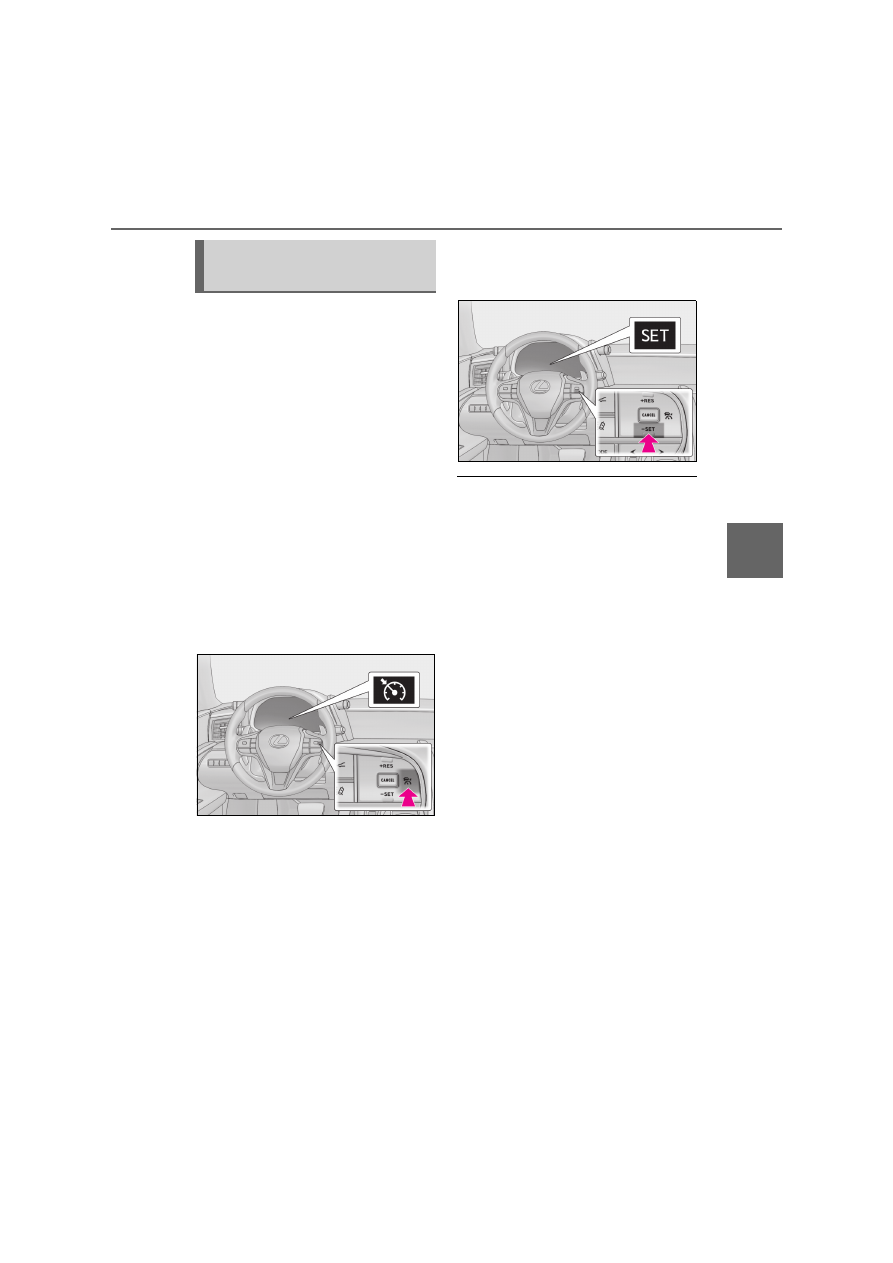
259
4
4-5. Using the driving support systems
Dr
ivin
g
When constant speed control mode is
selected, your vehicle will maintain a
set speed without controlling the vehi-
cle-to-vehicle distance. Select this
mode only when vehicle-to-vehicle
distance control mode does not func-
tion correctly due to a dirty radar sen-
sor, etc.
1
With the cruise control off, press
and hold the cruise control main
switch for 1.5 seconds or more.
Immediately after the switch is pressed, the
radar cruise control indicator will come on.
Afterwards, it switches to the cruise con-
trol indicator.
Switching to constant speed control mode
is only possible when operating the switch
with the cruise control off.
2
Accelerate or decelerate, with
accelerator pedal operation, to the
desired vehicle speed (at or above
approximately 40 km/h [25 mph])
and press the “-SET” switch to set
the speed.
Cruise control “SET” indicator will come
on.
The vehicle speed at the moment the
switch is released becomes the set speed.
Adjusting the speed setting:
P.256
Canceling and resuming the speed setting:
P.258
Q
Dynamic radar cruise control with full-
speed range can be set when
O
The shift position is in D.
O
Range 4 or higher of D has been selected
by using the paddle shift switch.
O
Vehicle speed is at or above approxi-
mately 50 km/h (30 mph).
However, when a preceding vehicle is
detected, the dynamic radar cruise con-
trol with full-speed range can be set even
if the vehicle speed is below approxi-
mately 50 km/h (30 mph).
Q
Accelerating after setting the vehicle
speed
The vehicle can accelerate by operating the
accelerator pedal. After accelerating, the
set speed resumes. However, during vehi-
cle-to-vehicle distance control mode, the
vehicle speed may decrease below the set
speed in order to maintain the distance to
the preceding vehicle.
Q
When the vehicle stops while follow-up
cruising
O
Pressing the “+RES” switch while the
vehicle ahead stops will resume follow-
up cruising if the vehicle ahead starts off
within approximately 3 seconds after the
switch is pressed.
O
If the vehicle ahead starts off within 3 sec-
onds after your vehicle stops, follow-up
cruising will be resumed.
Selecting constant speed con-
trol mode
260
4-5. Using the driving support systems
Q
Automatic cancelation of vehicle-to-
vehicle distance control mode
Vehicle-to-vehicle distance control mode is
automatically canceled in the following situ-
ations:
O
Actual vehicle speed falls at or below
approximately 40 km/h (25 mph) when
there are no vehicles ahead.
O
The preceding vehicle leaves the lane
when your vehicle is following at a vehicle
speed at or below approximately 40
km/h (25 mph). Otherwise, the sensor
can not properly detect the vehicle.
(“CRUISE NOT AVAILABLE No Pre-
ceding Vehicles” is displayed on the
multi-information display)
O
VSC is activated.
O
TRC is activated for a period of time.
O
When the VSC or TRC system is turned
off.
O
When snow mode is set.
O
The sensor cannot detect correctly
because it is covered in some way.
O
Pre-collision braking is activated.
O
The parking brake is operated.
O
The vehicle is stopped by system control
on a steep incline.
O
The following are detected when the
vehicle has been stopped by system con-
trol:
• The driver is not wearing a seat belt.
• The driver’s door is opened.
• The vehicle has been stopped for about 3
minutes
If vehicle-to-vehicle distance control mode
is automatically canceled for any other rea-
son, there may be a malfunction in the sys-
tem. Contact any authorized Lexus retailer
or Lexus authorized repairer, or any reli-
able repairer.
Q
Automatic cancelation of constant
speed control mode
Constant speed control mode is automati-
cally canceled in the following situations:
O
Actual vehicle speed is more than
approximately 16 km/h (10 mph) below
the set vehicle speed.
O
Actual vehicle speed falls below approxi-
mately 40 km/h (25 mph).
O
VSC is activated.
O
TRC is activated for a period of time.
O
When the VSC or TRC system is turned
off.
O
Pre-collision braking is activated.
If constant speed control mode is automati-
cally canceled for any other reason, there
may be a malfunction in the system. Con-
tact any authorized Lexus retailer or Lexus
authorized repairer, or any reliable
repairer.
Q
Brake system operation sound
If the brakes are applied automatically while
the vehicle is in vehicle-to-vehicle distance
control mode, a brake system operation
sound may be heard. This does not indicate
a malfunction.
Q
If “Radar Cruise Control Unavailable” is
shown on the multi-information display
The radar cruise control system cannot be
used temporarily. Use the system when it
becomes available again.
Q
Warning messages and buzzers for
dynamic radar cruise control with full-
speed range
Warning messages and buzzers are used to
indicate a system malfunction or to inform
the driver of the need for caution while driv-
ing. If a warning message is shown on the
multi-information display, read the message
and follow the instructions.
Q
When the sensor may not be correctly
detecting the vehicle ahead
In the case of the following and depending
on the conditions, operate the brake pedal
when deceleration of the system is insuffi-
cient or operate the accelerator pedal
when acceleration is required.
As the sensor may not be able to correctly
detect these types of vehicles, the approach
warning (
P.258) may not be activated.
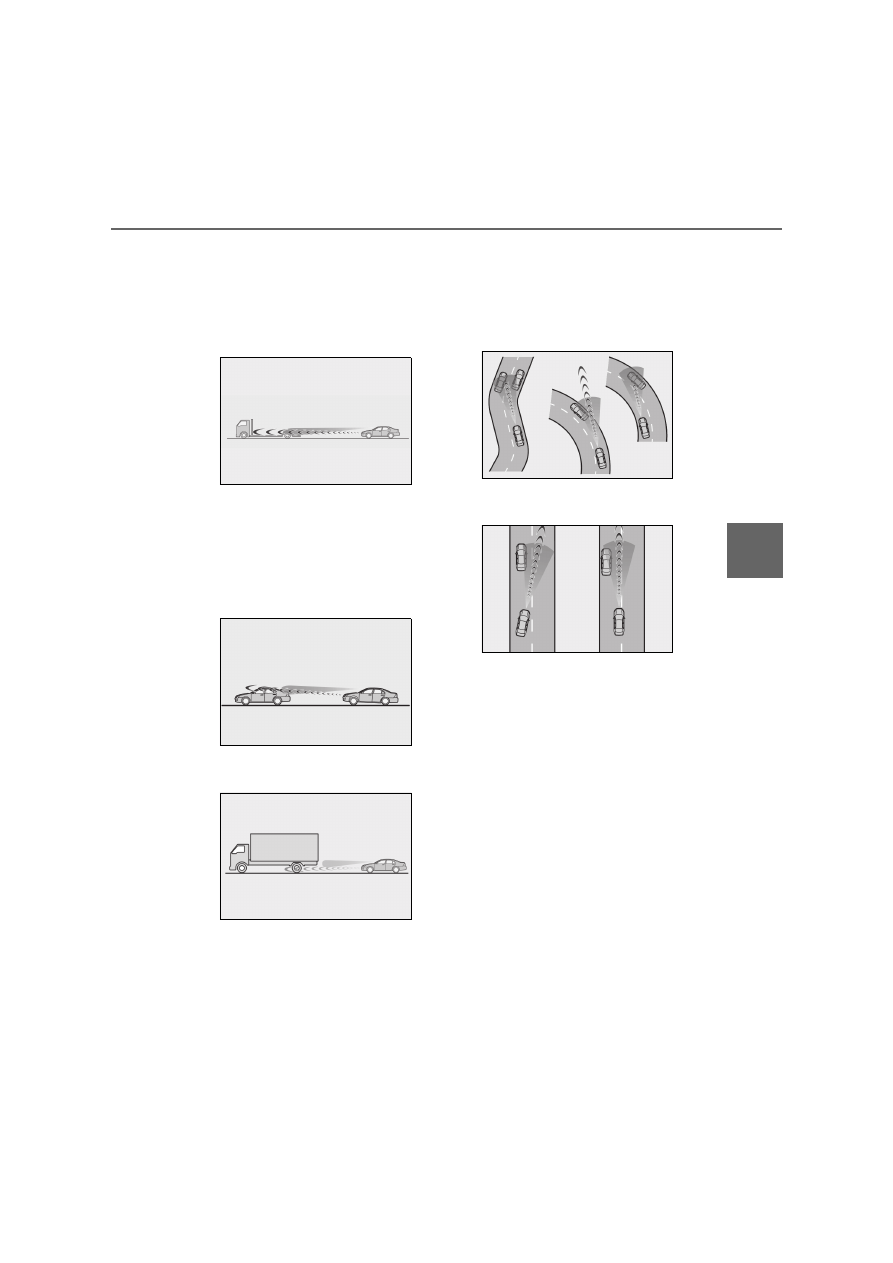
261
4
4-5. Using the driving support systems
Dr
ivin
g
O
Vehicles that cut in suddenly
O
Vehicles traveling at low speeds
O
Vehicles that are not moving in the same
lane
O
Vehicles with small rear ends (trailers
with no load on board, etc.)
O
Motorcycles traveling in the same lane
O
When water or snow thrown up by the
surrounding vehicles hinders the detect-
ing of the sensor
O
When your vehicle is pointing upwards
(caused by a heavy load in the luggage
compartment, etc.)
O
Preceding vehicle has an extremely high
ground clearance
Q
Conditions under which the vehicle-to-
vehicle distance control mode may not
function correctly
In the case of the following conditions,
operate the brake pedal (or accelerator
pedal, depending on the situation) as nec-
essary.
As the sensor may not be able to correctly
detect vehicles ahead, the system may not
operate properly.
O
When the road curves or when the lanes
are narrow
O
When steering wheel operation or your
position in the lane is unstable
O
When the vehicle ahead of you deceler-
ates suddenly
O
When driving on a road surrounded by a
structure, such as in a tunnel or on a
bridge
O
While the vehicle speed is decreasing to
the set speed after the vehicle acceler-
ates by depressing the accelerator pedal

262
4-5. Using the driving support systems
1
Normal mode/Custom mode
Normal mode and custom mode are
selected by pressing the driving mode
select switch. Each time the switch is
pressed, the driving mode changes
between normal mode and custom mode.
When custom mode is selected, the “Cus-
tom” indicator comes on.
Press the switch to change the driving
mode to normal mode when not in normal
mode.
• Normal mode
Provides an optimal balance of fuel econ-
omy, quietness, and dynamic performance.
Suitable for city driving.
When the shift position is in D, an appropri-
ate gear for sporty driving may automati-
cally be selected according to driver
performance and driving conditions.
• Custom mode
Allows you to drive with the power train,
chassis and air conditioning system func-
tions set to your preferred settings.
Custom mode settings can only be
changed on the drive mode customization
display of Center Display. (
P.301)
2
Comfort mode
By controlling the suspension, riding com-
fort is further enhanced. Suitable for city
driving.
When not in comfort mode and the driving
mode select switch is turned forward, the
“Comfort” indicator comes on.
3
Eco drive mode
Helps the driver accelerate in an eco-
friendly manner and improve fuel economy
through moderate throttle characteristics
and by controlling the operation of the air
conditioning system (heating/cooling).
When in comfort mode, if the driving mode
select switch is turned forward, the “Eco”
indicator comes on.
4
Sport mode
• SPORT S mode
Controls the transmission and engine to
provide quick, powerful acceleration. This
mode is suitable for when agile driving
response is desired, such as when driving
on roads with many curves.
When not in SPORT S mode, if the driving
mode select switch is turned backward, the
“Sport S” indicator comes on.
• SPORT S+ mode
Provides earlier downshift timing than
SPORT S mode in order to maintain a high
engine speed and provides faster gear
changes. This mode also changes the
Driving mode select switch
The driving modes can be selected
to suit driving condition.
Selecting the driving mode
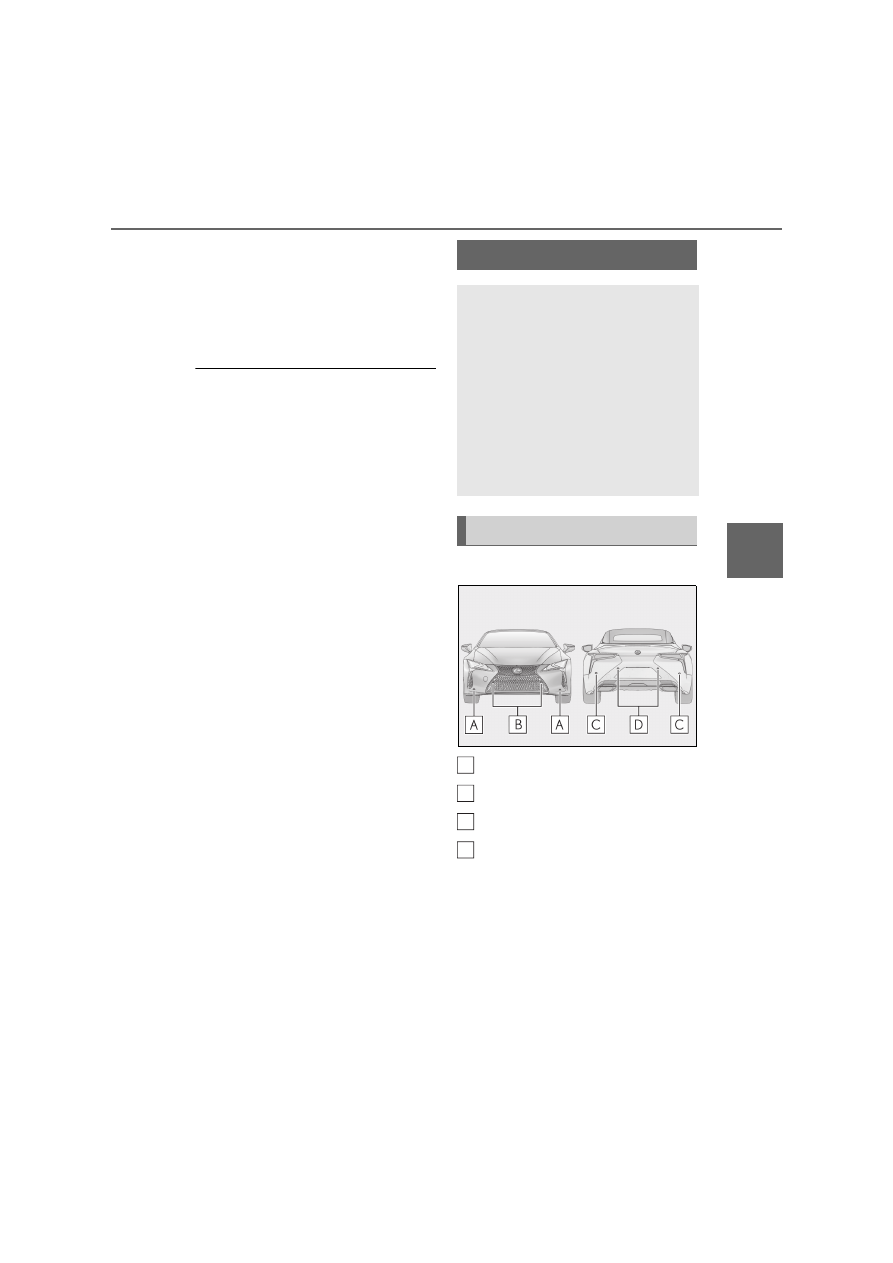
263
4
4-5. Using the driving support systems
Dr
ivin
g
steering feel, suspension control and
VDIM control, making it suitable for pow-
erful sporty driving.
When in SPORT S mode, if the driving
mode select switch is turned backward, the
“Sport S+” indicator comes on.
Q
Operation of the air conditioning sys-
tem in Eco drive mode
Eco drive mode controls the heating/cool-
ing operations and fan speed of the air con-
ditioning system to enhance fuel efficiency.
To improve air conditioning performance,
perform the following operations:
O
Adjust the fan speed (
P.307, 309)
O
Turn off Eco drive mode
Q
Automatic deactivation of sport mode
and custom mode
If the engine switch is turned off after driv-
ing in sport mode or custom mode, the
drive mode will be changed to normal
mode.
Q
Driving mode pop-up display
When the driving mode is changed, the
selected driving mode will be temporarily
displayed on the side display. (
P.303)
For custom mode, select “Setting” on the
display to customize the driving mode.
Q
Types of sensors
Front corner sensors
Front center sensors
Rear corner sensors
Rear center sensors
Q
Display
When the sensors detect an obstacle, a
graphic is shown on the multi-informa-
tion display, head-up display and Cen-
ter Display depending on the position
and distance to the obstacle.
Multi-information display and head-
Lexus parking assist-sensor
The distance from your vehicle to
nearby obstacles when parallel
parking or maneuvering into a
garage is measured by the sensors
and communicated via the multi-
information display, head-up dis-
play (if equipped), Center Display
and a buzzer. Always check the sur-
rounding area when using this sys-
tem.
System components
A
B
C
D
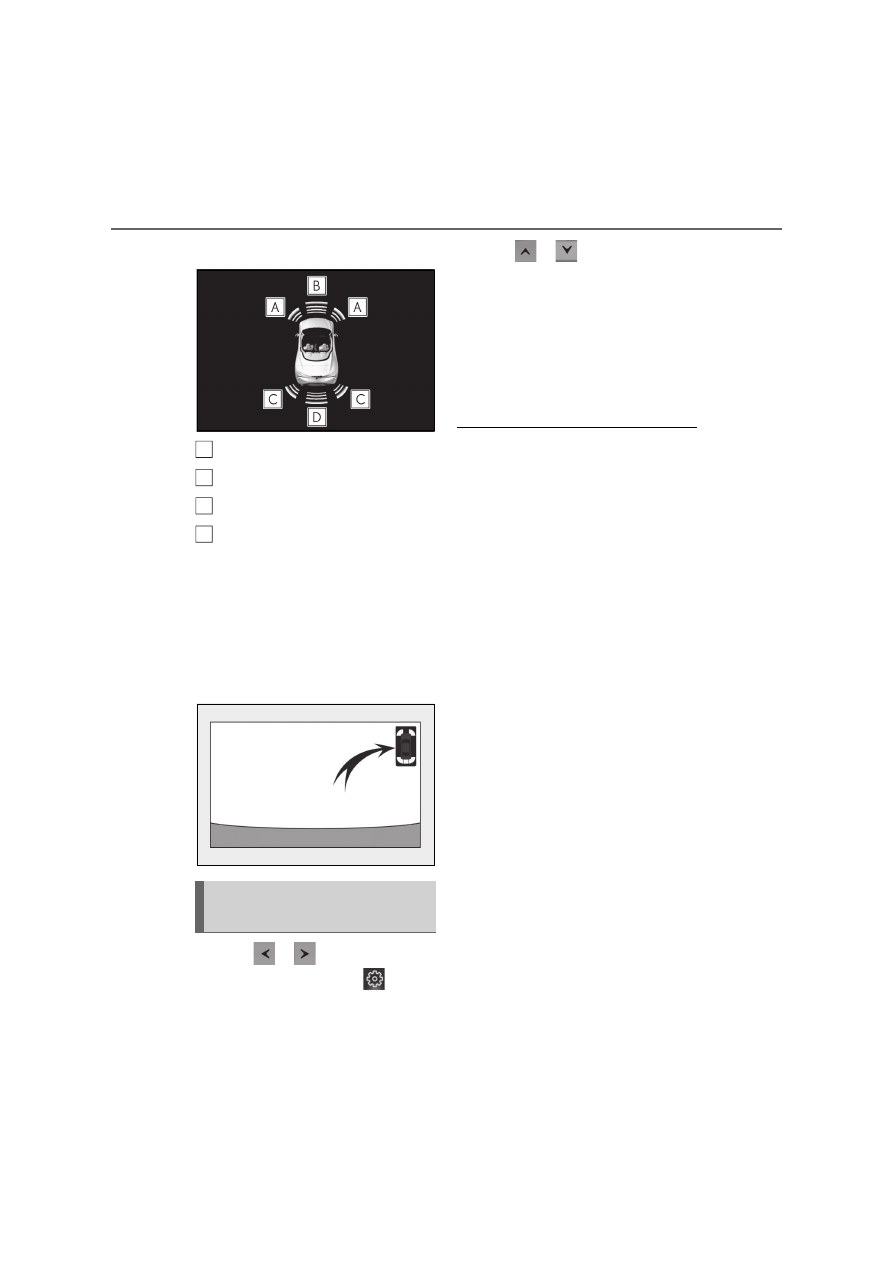
264
4-5. Using the driving support systems
up display
Front corner sensor detection
Front center sensor detection
Rear corner sensor detection
Rear center sensor detection
Center Display
A graphic is shown when the Lexus park-
ing assist monitor is displayed (insert dis-
play)
A simplified image is displayed on the
upper right corner of Center Display when
an obstacle is detected.
1
Press
or
of the meter con-
trol switches, and select
.
2
Press
or
of the meter con-
trol switches, and select “Parking
Assist”, and press “OK”.
When the Lexus parking assist-sensor
is turned on, the Lexus parking assist-
sensor indicator comes on to inform
the driver that the system is opera-
tional.
Q
The Lexus parking assist-sensor can be
operated when
O
Front center sensors:
• The engine switch is in ON.
• The shift position is in a position other
than P or R.
• The vehicle speed is less than about 10
km/h (6 mph).
O
Front corner sensors:
• The engine switch is in ON.
• The shift position is in a position other
than P.
• The vehicle speed is less than about 10
km/h (6 mph).
(At any speed when the shift position is in
R)
O
Rear corner and rear center sensors:
• The engine switch is in ON.
• The shift position is in R.
Q
Muting the buzzer sound
O
To mute the buzzer sound:
The buzzer can be temporarily muted by
pressing “OK” of the meter control
switches while an obstacle detection dis-
play is shown on the multi-information dis-
play.
O
To cancel the mute:
Mute will be automatically canceled in the
following situations.
• When the shift position is changed
(except shifting from D to N, or N to D)
• When the vehicle speed has reached or
exceeded 10 km/h (6 mph) with the shift
position in D
• When the Lexus parking assist-sensor is
turned off once and turned on again
Turning Lexus parking assist-
sensor on/off
A
B
C
D
265
4
4-5. Using the driving support systems
Dr
ivin
g
• When the engine switch is turned off
once and turned to ON again
Q
If “Clean Parking Assist Sensor” is dis-
played on the multi-information display
A sensor may be dirty or covered with snow
or ice. In such cases, if it is removed from
the sensor, the system should return to nor-
mal.
Also, due to the sensor being frozen at low
temperatures, a malfunction display may
appear or an obstacle may not be detected.
If the sensor thaws out, the system should
return to normal.
Q
If “Parking Assist Malfunction” or
“Parking Assist Malfunction Visit Your
Dealer” is displayed on the multi-infor-
mation display
There is a malfunction and the device may
not be working properly.
Have the vehicle inspected by any autho-
rized Lexus retailer or Lexus authorized
repairer, or any reliable repairer.
Q
Sensor detection information
O
The sensor’s detection areas are limited
to the areas around the vehicle’s front
and rear bumpers.
O
Certain vehicle conditions and the sur-
rounding environment may affect the
ability of the sensor to correctly detect
obstacles. Particular instances where this
may occur are listed below.
• There is dirt, snow or ice on the sensor.
(Wiping the sensors will resolve this
problem.)
• The sensor is frozen. (Thawing the area
will resolve this problem.)
In especially cold weather, if a sensor is
frozen the screen may show an abnormal
display, or obstacles may not be
detected.
• The sensor is covered in any way.
• The vehicle is leaning considerably to
one side.
• On an extremely bumpy road, on an
incline, on gravel, or on grass.
• The vicinity of the vehicle is noisy due to
vehicle horns, motorcycle engines, air
brakes of large vehicles, or other loud
noises producing ultrasonic waves.
• There is another vehicle equipped with
parking assist sensor in the vicinity.
• The sensor is splashed with water or
heavy rain.
• The vehicle is equipped with a fender
pole or wireless antenna.
• Towing eyelets are installed.
• The bumper or sensor receives a strong
impact.
• The vehicle is approaching a tall or
curved curb.
• In harsh sunlight or intense cold weather.
• The area directly under the bumpers is
not detected.
• If obstacles draw too close to the sensor.
• A non-genuine Lexus suspension (low-
ered suspension etc.) is installed.
• People may not be detected if they are
wearing certain types of clothing.
In addition to the examples above, there are
instances in which, because of their shape,
signs and other objects may be judged by
the sensor to be closer than they are.
O
The shape of the obstacle may prevent
the sensor from detecting it. Pay particu-
lar attention to the following obstacles:
• Wires, fences, ropes, etc.
• Cotton, snow and other materials that
absorb sound waves
• Sharply-angled objects
• Low obstacles
• Tall obstacles with upper sections pro-
jecting outwards in the direction of your
vehicle
O
The following situations may occur
during use.
• Depending on the shape of the obstacle
and other factors, the detection distance
may shorten, or detection may be impos-
sible.
• Obstacles may not be detected if they
are too close to the sensor.
• There will be a short delay between
obstacle detection and display. Even at
slow speeds, there is a possibility that the
obstacle will come within the sensor’s
detection areas before the display is
shown and the warning beep sounds.
• Thin posts or objects lower than the sen-
sor may not be detected when
approached, even if they have been
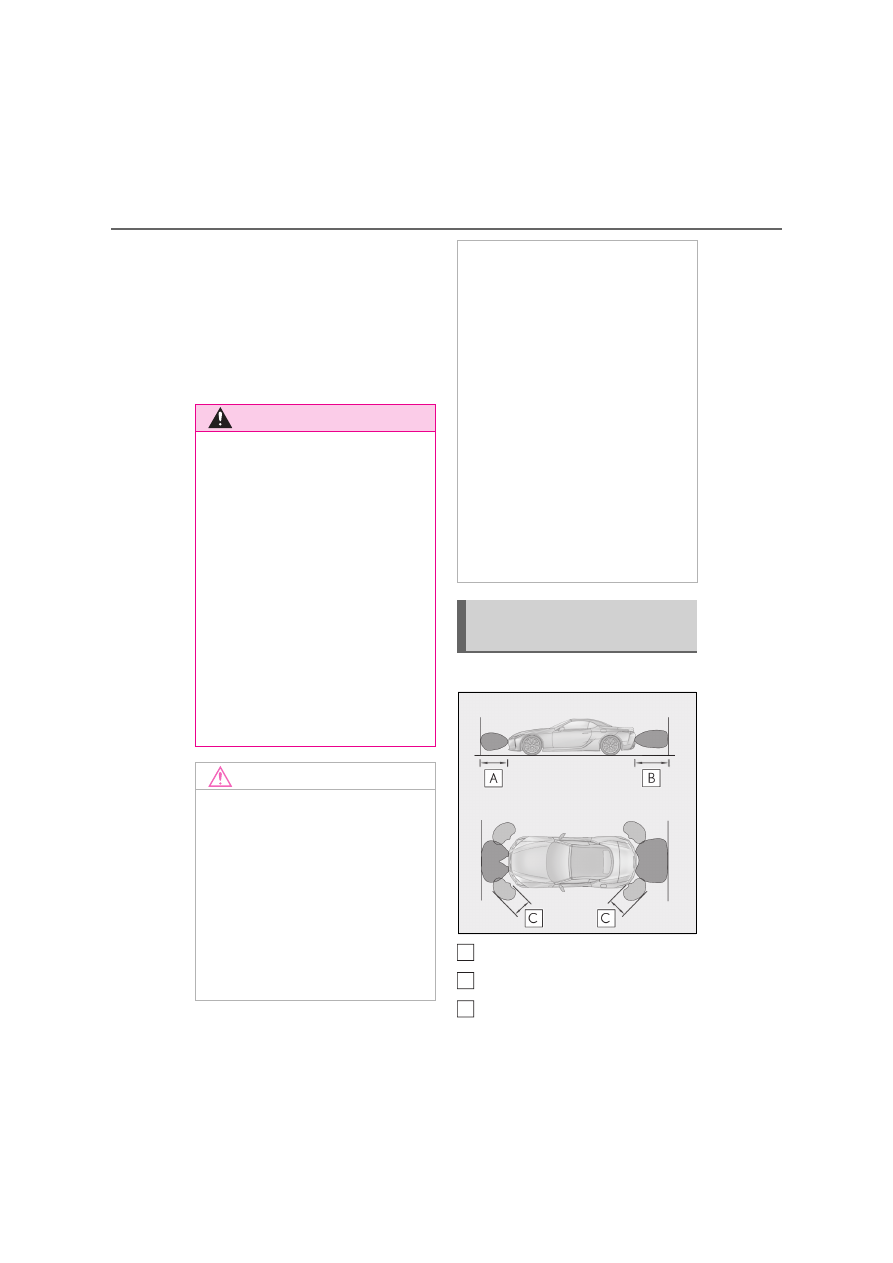
266
4-5. Using the driving support systems
detected once.
• It might be difficult to hear beeps due to
the volume of the audio system or air flow
noise of the air conditioning system.
• It might be difficult to hear beeps due to
the sounds of other systems.
Q
Customization
Some functions can be customized.
(
P.435)
Q
Detection range of the sensors
Approximately 100 cm (3.3 ft.)
Approximately 150 cm (4.9 ft.)
Approximately 60 cm (2.0 ft.)
WARNING
Q
When using the Lexus parking assist-
sensor
Observe the following precautions.
Failing to do so may result in the vehicle
being unable to be driven safely and pos-
sibly cause an accident.
O
Do not use the sensor at speeds in
excess of 10 km/h (6 mph).
O
The sensors’ detection areas and reac-
tion times are limited. When moving
forward or reversing, check the areas
surrounding the vehicle (especially the
sides of the vehicle) for safety, and
drive slowly, using the brake to control
the vehicle’s speed.
O
Do not install accessories within the
sensors’ detection areas.
NOTICE
Q
When using Lexus parking assist-sen-
sor
In the following situations, the system
may not function correctly due to a sen-
sor malfunction etc. Have the vehicle
checked by any authorized Lexus
retailer or Lexus authorized repairer, or
any reliable repairer.
O
The Lexus parking assist-sensor oper-
ation display flashes or shows continu-
ously, and a beep sounds when no
obstacles are detected.
O
If the area around a sensor collides
with something, or is subjected to
strong impact.
O
If the bumper or grille collides with
something.
O
If the display flashes or shows continu-
ously without beeping, except when
the mute function has been turned on.
O
If a display error occurs, first check the
sensor.
If the error occurs even when there is
no ice, snow or mud on the sensor, it is
likely that the sensor is malfunctioning.
Q
Notes when washing the vehicle
Do not apply intensive bursts of water or
steam to the sensor area.
Doing so may result in the sensor mal-
functioning.
Sensor detection display, obsta-
cle distance
A
B
C
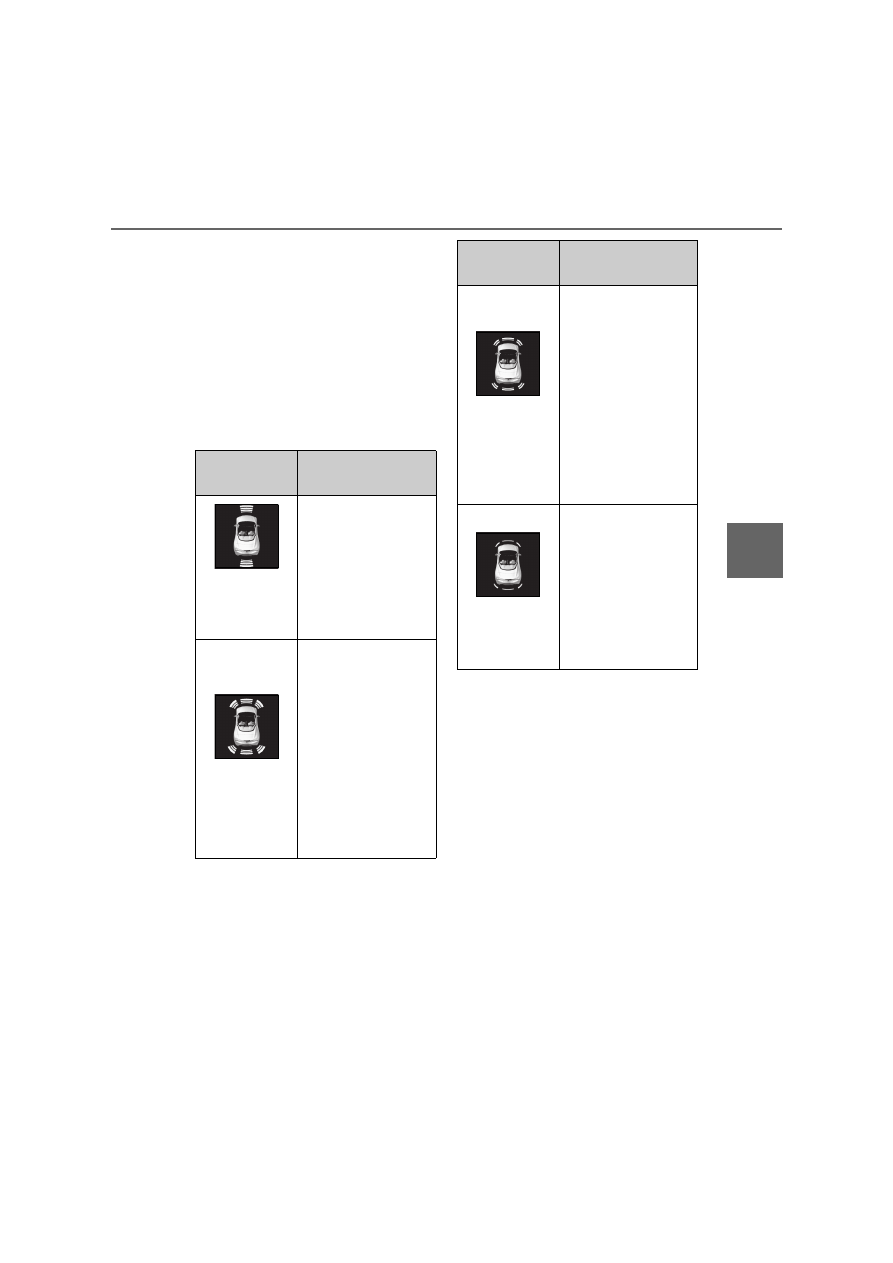
267
4
4-5. Using the driving support systems
Dr
ivin
g
The diagram shows the detection range of
the sensors. Note that the sensors cannot
detect obstacles that are extremely close
to the vehicle.
The range of the sensors may change
depending on the shape of the object etc.
Q
Multi-information display, head-up
display and Center Display
Sensors that detect an obstacle will illu-
minate continuously or blink.
*1
: The illustrations show the graphics on
the Multi-information display, and differ
from the graphics on the head-up dis-
play and Center Display. Depending on
the distance of the obstacle, the sensor
display on Center Display illuminates or
blinks in various cycles, although the
width of it does not change.
*2
: Multi-information display and head-up
display
*3
: Center Display
Q
Buzzer operation and distance to
an obstacle
A buzzer sounds when the sensors are
operating.
The buzzer beeps faster as the vehi-
cle approaches an obstacle. When
Display
*1
Approximate distance
to obstacle
(continuous
*2
or
blinking
slowly
*3
)
Front center sensor:
100 cm (3.3 ft.) to 50
cm (1.6 ft.)
Rear center sensor:
150 cm (4.9 ft.) to 60
cm (2.0 ft.)
(continuous
*2
or
blinking
*3
)
Front center sensor:
50 cm (1.6 ft.) to 40 cm
(1.3 ft.)
Rear center sensor:
60 cm (2.0 ft.) to 45
cm (1.5 ft.)
Front and rear corner
sensor:
60 cm (2.0 ft.) to 45
cm (1.5 ft.)
(continuous
*2
or
blinking rap-
idly
*3
)
Front center sensor:
40 cm (1.3 ft.) to 30 cm
(1.0 ft.)
Rear center sensor:
45 cm (1.5 ft.) to 35 cm
(1.1 ft.)
Front and rear corner
sensor:
45 cm (1.5 ft.) to 30 cm
(1.0 ft.)
(blinking
*2
or
continuous
*3
)
Front center sensor:
Less than 30 cm (1.0 ft.)
Rear center sensor:
Less than 35 cm (1.1 ft.)
Front and rear corner
sensor:
Less than 30 cm (1.0 ft.)
Display
*1
Approximate distance
to obstacle

268
4-5. Using the driving support systems
the vehicle comes within the follow-
ing distance of the obstacle, the
buzzer sounds continuously:
• Front center sensors: Approximately 30
cm (1.0 ft.)
• Corner sensors: Approximately 30 cm
(1.0 ft.)
• Rear center sensors: Approximately 35
cm (1.1 ft.)
When 2 or more obstacles are
detected simultaneously, the buzzer
system responds to the nearest
obstacle. If one or both come within
the above distances, the beep will
repeat a long tone, followed by fast
beeps.
*
: If equipped
BSM (Blind Spot Monitor)
*
The Blind Spot Monitor uses the
sensors installed behind the rear
bumper. The system is intended to
assist the driver check areas that
are not easily visible. The system
has the following 2 functions:
The BSM (Blind Spot Monitor)
function
Assists the driver in making a deci-
sion when changing lanes
The RCTA (Rear Crossing Traffic
Alert) function
Assists the driver when backing up
These functions use same sensors.
System components
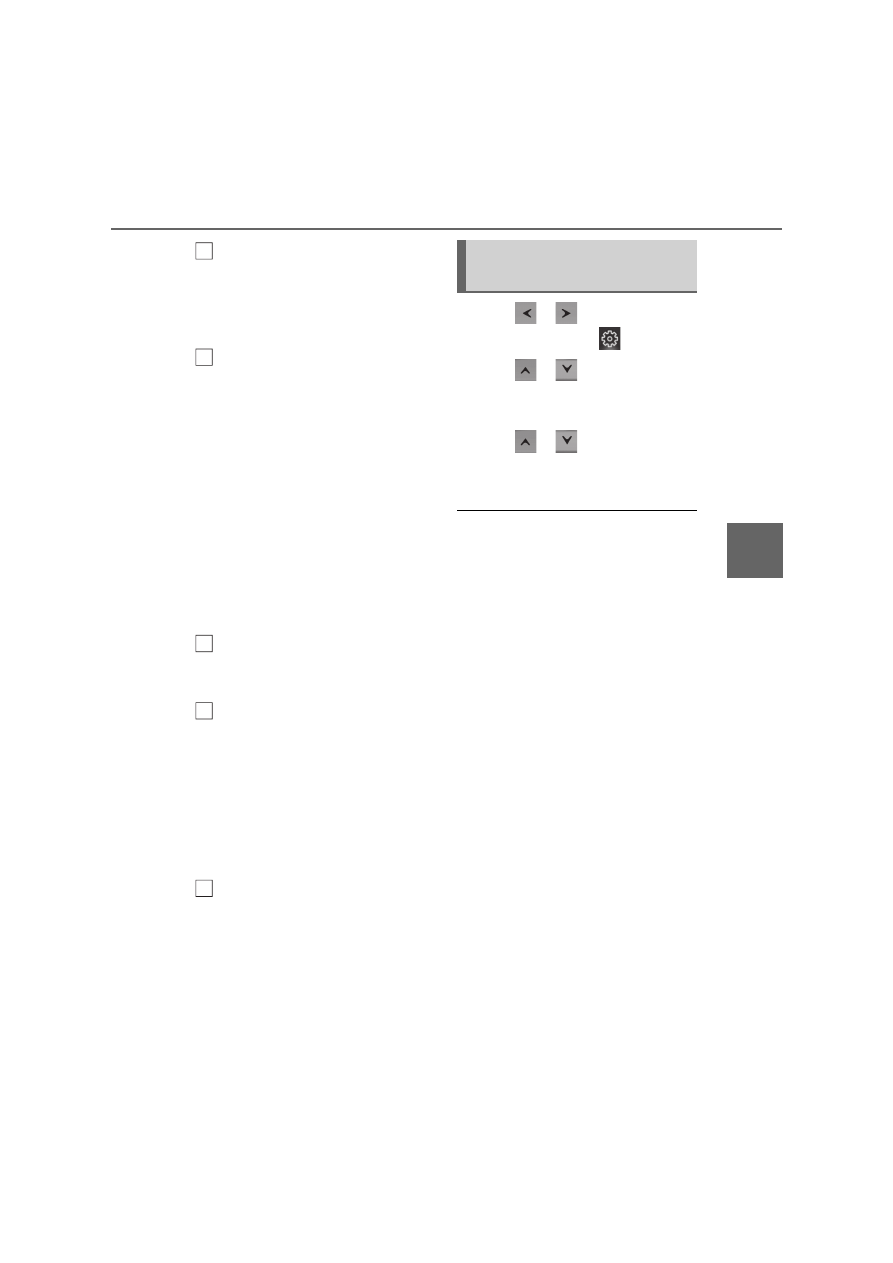
269
4
4-5. Using the driving support systems
Dr
ivin
g
Multi-information display
The BSM function/RCTA function can be
turned on/off.
The RCTA function is available when the
BSM function is on.
Outside rear view mirror indicators
BSM function:
When a vehicle is detected in a blind spot
of the outside rear view mirrors or
approaching rapidly from behind into a
blind spot, the outside rear view mirror
indicator on the detected side will illumi-
nate. If the turn signal lever is operated
toward the detected side, the outside rear
view mirror indicator will flash.
RCTA function:
When a vehicle approaching from the right
or left at the rear of the vehicle is detected,
both outside rear view mirror indicators
will flash.
BSM indicator/RCTA indicator
When the BSM function/RCTA function is
turned on, the indicator comes on.
Monitor screen display (RCTA
function only)
If a vehicle approaching from the right or
left at the rear of the vehicle is detected,
the RCTA icon (
P.287) for the detected
side will be displayed on the monitor
screen. This illustration shows an example
of a vehicle approaching from the left at
the rear of the vehicle.
RCTA buzzer (RCTA function
only)
If a vehicle approaching from the right or
left at the rear of the vehicle is detected, a
buzzer will sound. The buzzer also sounds
for approximately 1 second immediately
after the BSM function is operated to turn
the system on.
1
Press
or
of the meter con-
trol switches, select
.
2
Press
or
of the meter con-
trol switches, select “BSM”, and
press “OK”.
3
Press
or
of the meter con-
trol switches, select “BSM” or
“RCTA”, and press “OK”.
Q
Outside rear view mirror indicator visi-
bility
In strong sunlight, the outside rear view mir-
ror indicator may be difficult to see.
Q
Hearing the RCTA buzzer
The RCTA buzzer may be difficult to hear
over loud noises, such as if the audio system
volume is high.
Q
When “Blind Spot Monitor Unavailable”
is shown on the multi-information dis-
play
Water, snow, mud, etc., may be built up in
the vicinity of the sensor area of the
bumper. (
P.282) Removing the water,
snow, mud, etc., from the vicinity of the sen-
sor area of the bumper should return it to
normal.
Also, the sensor may not function normally
when used in extremely hot or cold
weather.
Q
When “Blind Spot Monitor System Mal-
function Visit Your Dealer” is shown on
the multi-information display
There may be a sensor malfunction or volt-
age abnormality. Have the vehicle
inspected at any authorized Lexus retailer
or Lexus authorized repairer, or any reli-
able repairer.
Q
Customization
Some functions can be customized.
A
B
C
D
E
Turning the BSM func-
tion/RCTA function on/off
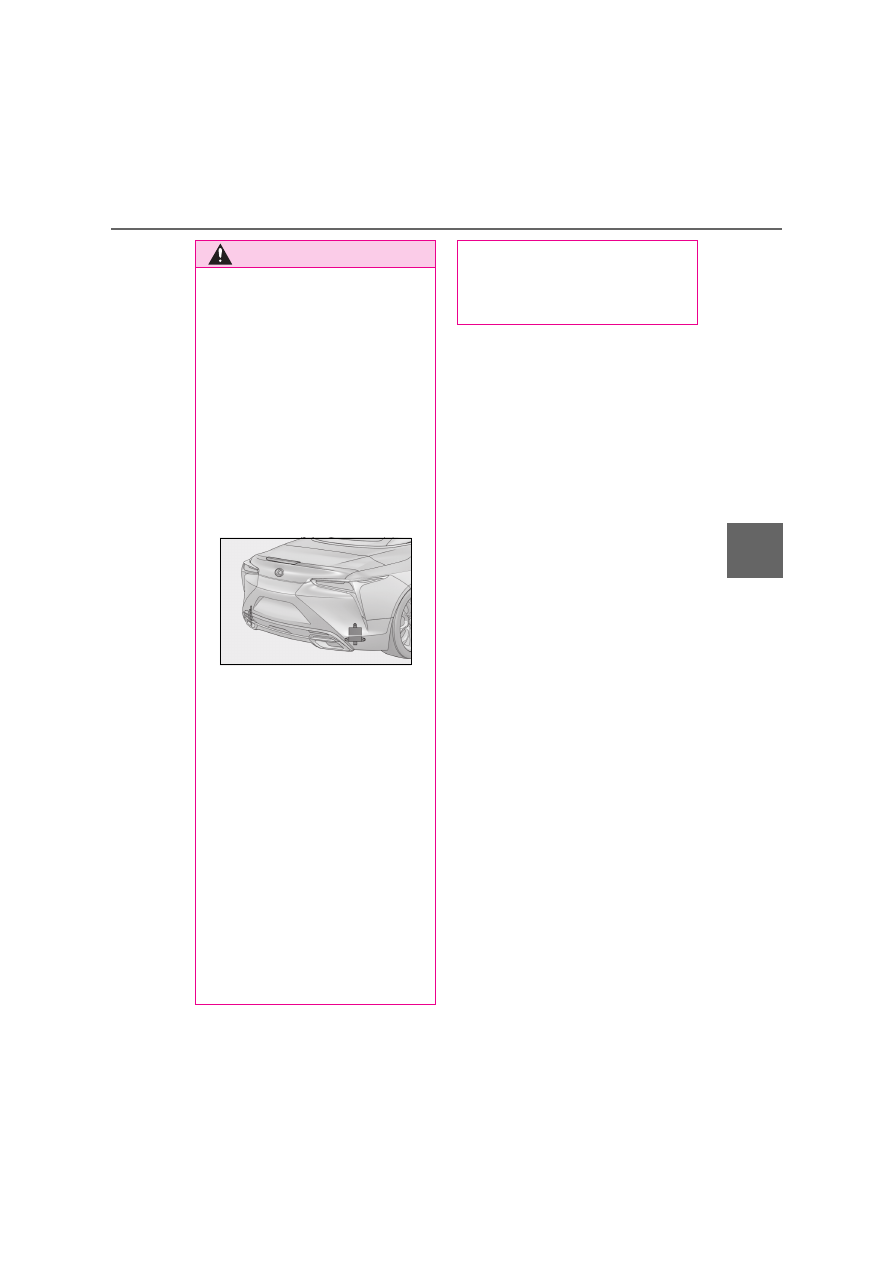
283
4
4-5. Using the driving support systems
Dr
ivin
g
WARNING
O
Keep the sensors and the surrounding
areas on the rear bumper clean at all
times.
If a sensor or its surrounding area on
the rear bumper is dirty or covered
with snow, the Blind Spot Monitor may
not operate and a warning message
(
P.269) will be displayed. In this sit-
uation, clear off the dirt or snow and
drive the vehicle with the operation
conditions of the BSM function
(
P.285) satisfied for approximately
10 minutes. If the warning message
does not disappear, have the vehicle
inspected by any authorized Lexus
retailer or Lexus authorized repairer,
or any reliable repairer.
O
Do not subject a sensor or its sur-
rounding area on the rear bumper to a
strong impact.
If a sensor is moved even slightly off
position, the system may malfunction
and vehicles may not be detected cor-
rectly.
In the following situations, have your
vehicle inspected by any authorized
Lexus retailer or Lexus authorized
repairer, or any reliable repairer.
• A sensor or its surrounding area is
subject to a strong impact.
• If the surrounding area of a sensor is
scratched or dented, or part of them
has become disconnected.
O
Do not disassemble the sensor.
O
Do not attach stickers to the sensor or
surrounding area on the rear bumper.
O
Do not modify the sensor or surround-
ing area on the rear bumper.
O
Do not paint the rear bumper any
color other than an official Lexus color.

284
4-5. Using the driving support systems
Q
Operation of the BSM function
The BSM function uses radar sensors to detect the following vehicles traveling in
adjacent lanes and advises the driver of the presence of such vehicles via the indi-
cators on the outside rear view mirrors.
Vehicles that are traveling in areas that are not visible using the outside rear
view mirrors (the blind spots)
Vehicles that are approaching rapidly from behind in areas that are not visible
using the outside rear view mirrors (the blind spots)
Q
BSM function detection areas
The areas that vehicles can be detected in are outlined below.
The range of each detection area is:
Approximately 0.5 m (1.6 ft.) to 3.5 m (11.5 ft.) from either side of the vehicle
*1
Approximately 1 m (3.3 ft.) forward of the rear bumper
Approximately 3 m (9.8 ft.) from the rear bumper
Approximately 3 m (9.8 ft.) to 60 m (197 ft.) from the rear bumper
*2
*1
: The area between the side of the vehicle and 0.5 m (1.6 ft.) from the side of the vehicle
BSM function
A
B
A
B
C
D
285
4
4-5. Using the driving support systems
Dr
ivin
g
cannot be detected.
*2
: The greater the difference in speed between your vehicle and the detected vehicle is,
the farther away the vehicle will be detected, causing the outside rear view mirror indi-
cator to illuminate or flash.
Q
The BSM function is operational when
The BSM function is operational when all of
the following conditions are met:
O
The BSM function is on.
O
The shift position is in a position other
than R.
O
The vehicle speed is greater than
approximately 16 km/h (10 mph).
Q
The BSM function will detect a vehicle
when
The BSM function will detect a vehicle pres-
ent in the detection area in the following sit-
uations:
O
A vehicle in an adjacent lane overtakes
your vehicle.
O
You overtake a vehicle in adjacent lane
slowly.
O
Another vehicle enters the detection
area when it changes lanes.
Q
Conditions under which the BSM func-
tion will not detect a vehicle
The BSM function is not designed to detect
the following types of vehicles and/or
objects:
O
Small motorcycles, bicycles, pedestrians,
etc.
*
O
Vehicles traveling in the opposite direc-
tion
O
Guardrails, walls, signs, parked vehicles
and similar stationary objects
*
O
Following vehicles that are in the same
lane
*
O
Vehicles traveling 2 lanes away from
your vehicle
*
O
Vehicles which are being overtaken rap-
idly by your vehicle.
*
*
: Depending on the conditions, detection
of a vehicle and/or object may occur.
Q
Conditions under which the BSM func-
tion may not function correctly
O
The BSM function may not detect vehi-
cles correctly in the following situations:
• When the sensor is misaligned due to a
strong impact to the sensor or its sur-
rounding area
• When mud, snow, ice, a sticker, etc. is
covering the sensor or surrounding area
on the rear bumper
• When driving on a road surface that is
wet with standing water during bad
weather, such as heavy rain, snow, or fog
• When multiple vehicles are approaching
with only a small gap between each vehi-
cle
• When the distance between your vehicle
and a following vehicle is short
• When there is a significant difference in
speed between your vehicle and the
vehicle that enters the detection area
• When the difference in speed between
your vehicle and another vehicle is
changing
• When a vehicle enters a detection area
traveling at about the same speed as your
vehicle
• As your vehicle starts from a stop, a vehi-
cle remains in the detection area
• When driving up and down consecutive
steep inclines, such as hills, dips in the
road, etc.
• When driving on roads with sharp bends,
consecutive curves, or uneven surfaces
• When vehicle lanes are wide, or when
driving on the edge of a lane, and the
vehicle in an adjacent lane is far away
from your vehicle
• When an accessory (such as a bicycle
carrier) or towing eyelet is installed to the
rear of the vehicle
• When there is a significant difference in
height between your vehicle and the
vehicle that enters the detection area
• Immediately after the BSM function is
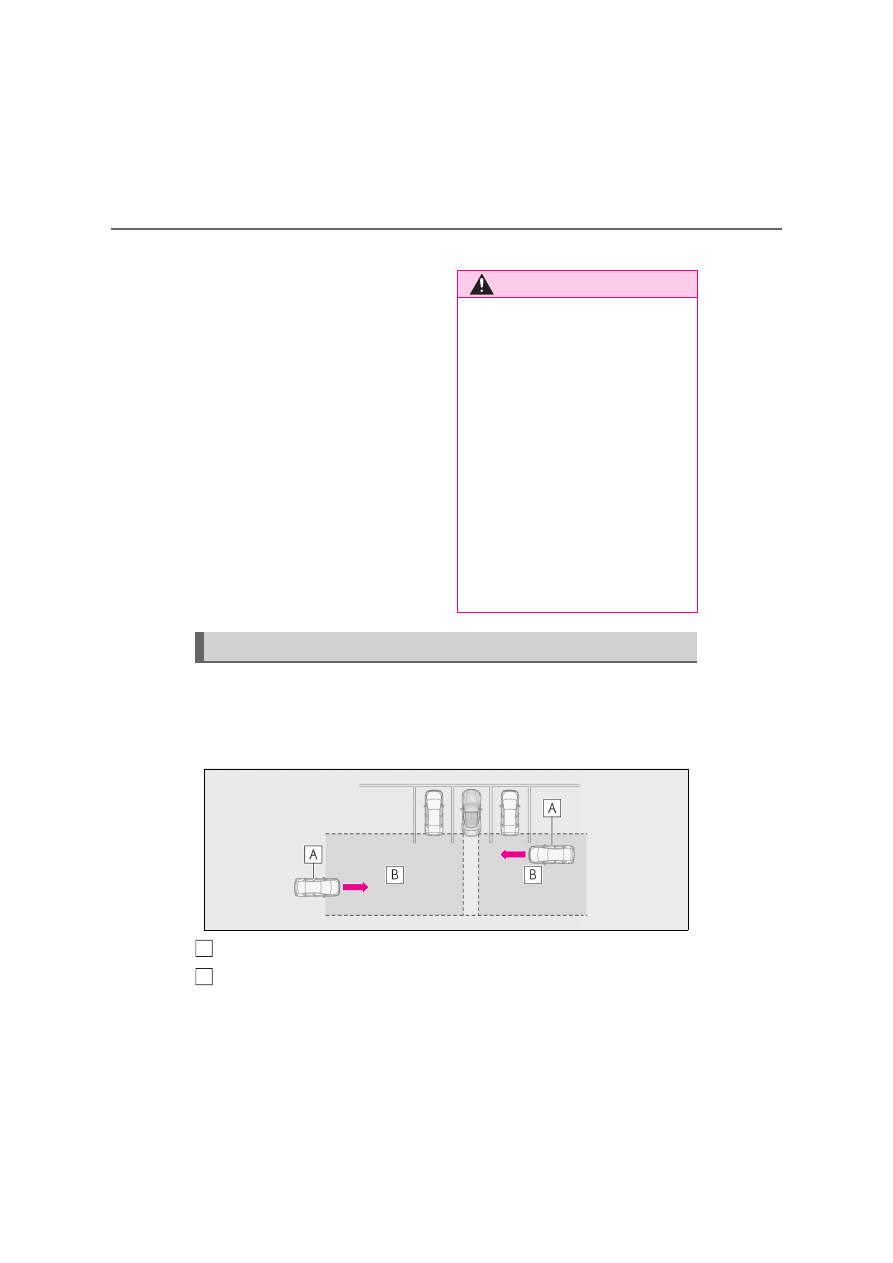
286
4-5. Using the driving support systems
turned on
O
Instances of the BSM function unneces-
sarily detecting a vehicle and/or object
may increase in the following situations:
• When the sensor is misaligned due to a
strong impact to the sensor or its sur-
rounding area
• When the distance between your vehicle
and a guardrail, wall, etc. that enters the
detection area is short
• When driving up and down consecutive
steep inclines, such as hills, dips in the
road, etc.
• When vehicle lanes are narrow, or when
driving on the edge of a lane, and a vehi-
cle traveling in a lane other than the adja-
cent lanes enters the detection area
• When driving on roads with sharp bends,
consecutive curves, or uneven surfaces
• When the tires are slipping or spinning
• When the distance between your vehicle
and a following vehicle is short
• When an accessory (such as a bicycle
carrier) or towing eyelet is installed to the
rear of the vehicle
Q
Operation of the RCTA function
The RCTA function uses radar sensors to detect vehicles approaching from the
right or left at the rear of the vehicle and alerts the driver of the presence of such
vehicles by flashing the outside rear view mirror indicators and sounding a buzzer.
Approaching vehicles
Detection areas of approaching vehicles
WARNING
Q
Cautions regarding the use of the
function
The driver is solely responsible for safe
driving. Always drive safely, taking care
to observe your surroundings.
The BSM function is a supplementary
function which alerts the driver that a
vehicle is in a blind spot of the outside
rear view mirrors or is approaching rap-
idly from behind into a blind spot. Do not
overly rely on the BSM function. As the
function cannot judge if it is safe to
change lanes, over reliance could lead to
an accident resulting in death or serious
injury.
As the system may not function correctly
under certain conditions, the driver’s
own visual confirmation of safety is nec-
essary.
RCTA function
A
B
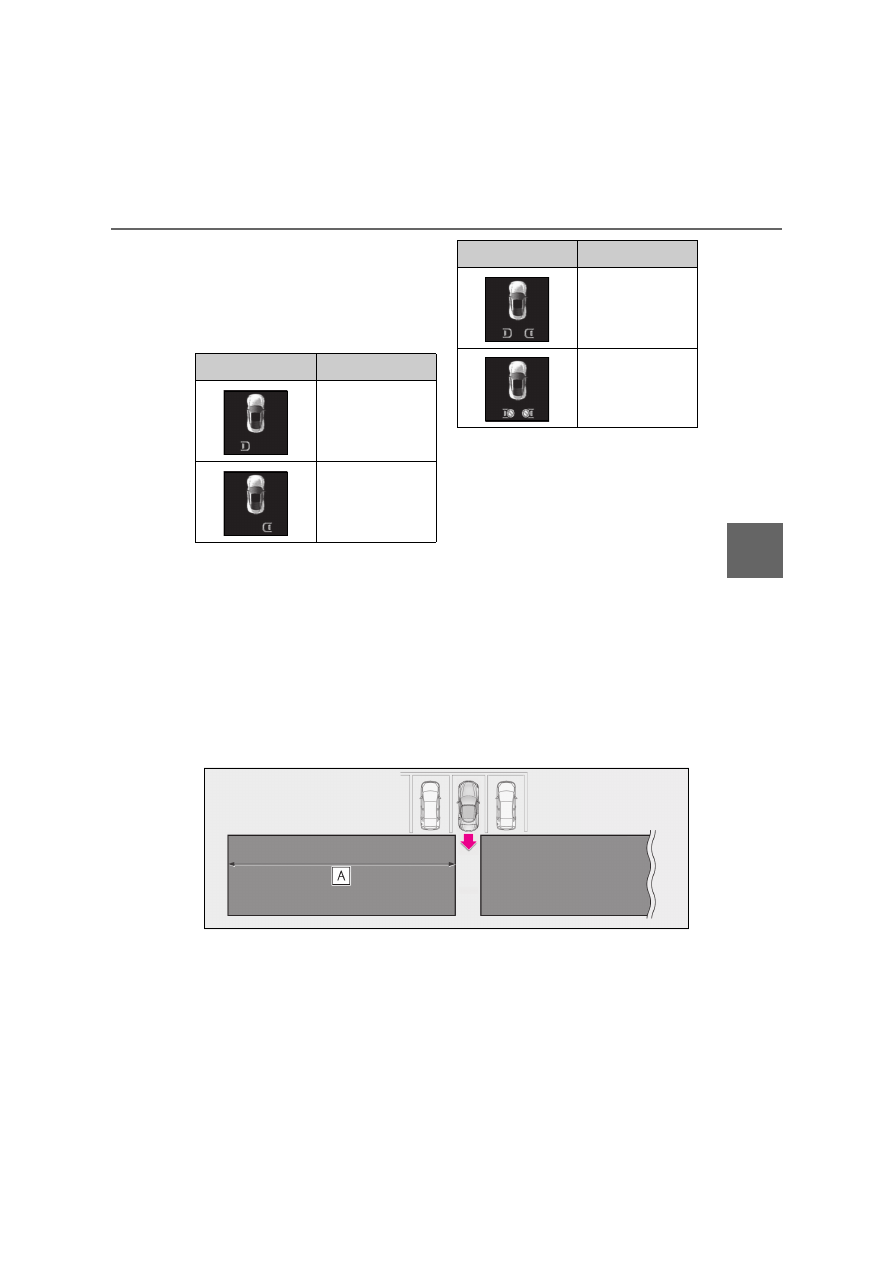
287
4
4-5. Using the driving support systems
Dr
ivin
g
Q
RCTA icon display
When a vehicle approaching from the
right or left at the rear of the vehicle is
detected, the following will be dis-
played on the monitor screen
Q
RCTA function detection areas
The areas that vehicles can be detected in are outlined below.
The buzzer can alert the driver of faster
vehicles approaching from farther away.
Display
Content
A vehicle is
approaching from
the left at the rear of
the vehicle
A vehicle is
approaching from
the right at the rear
of the vehicle
Vehicles are
approaching from
both sides of the
vehicle
The RCTA function
is malfunctioning
(
P.269)
Display
Content

Нет комментариевНе стесняйтесь поделиться с нами вашим ценным мнением.
Текст